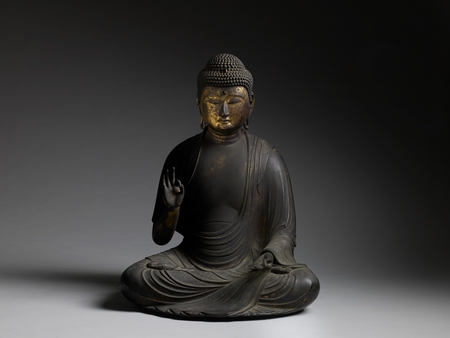Product Description
7527 A lacquer and gilt wood figure of a seated Amida Nyorai (Amitābha) dressed in a flowing robe. The head is adorned with crystals representing the byakugō (white spiralling hair) on the forehead and the nikkei-shu (red jewel on the protrusion on top of the Buddha’s head). The right arm raised and the left arm extended with the forefinger and thumb of each hand forming a circle, which represents the raigōin mudra, welcoming the believer into Amida’s Great Western Paradise.
Japan, 15th/16th century, Muromachi/Momoyama period
Dimensions: H. 52.5cm x W. 41.5cm x D. 39.5cm (20¾” x 16½” x 15¾”)
Provenance: Private Collection, Kyoto
Belief in Amida as Lord of the Western Paradise rose in popularity during the late 10th century. Based primarily on the concept of salvation through faith, it was not only a religion appealing to a broad range of people, but also a direct assertion of piety against the dogmatic and esoteric ritual of the more traditional Tendai and Shingon sects. In Amida’s Western Paradise the faithful are reborn, to progress through various stages of increasing awareness until finally achieving complete enlightenment.
Another factor that engendered faith in Amida was a widespread belief of the Three Periods of the Law known as the Days of the Dharma (the Buddhist teachings). This was an all-encompassing concept of society’s rise and fall that originated in Indian Buddhism and later became widespread in China and Japan. It foretold of the world’s ultimate decay and the complete disappearance of Buddhist practice. At the time, the Days of the Dharma in Japan were divided into three periods. The first phase, the Age of Shōbō, was said to last 1000 years after the death of the Buddha. It was believed to be a golden period during which followers had the capacity to understand the Dharma. The second phase, the Age of Zōhō, was also to last 1000 years, during which Buddhist practice would begin to weaken. The third and final phase lasting 3,000 years, the Age of Mappō, was when Buddhist faith would deteriorate and no longer be practiced. In Japan the Age of Mappō was said to begin in 1052 AD, and a sense of foreboding thus filled the land, with people from all classes yearning for salvation leading to a widespread practice of continuously repeating the mantra of Amida Buddha.
Radio Carbon Dating Ref: RCD-9055








